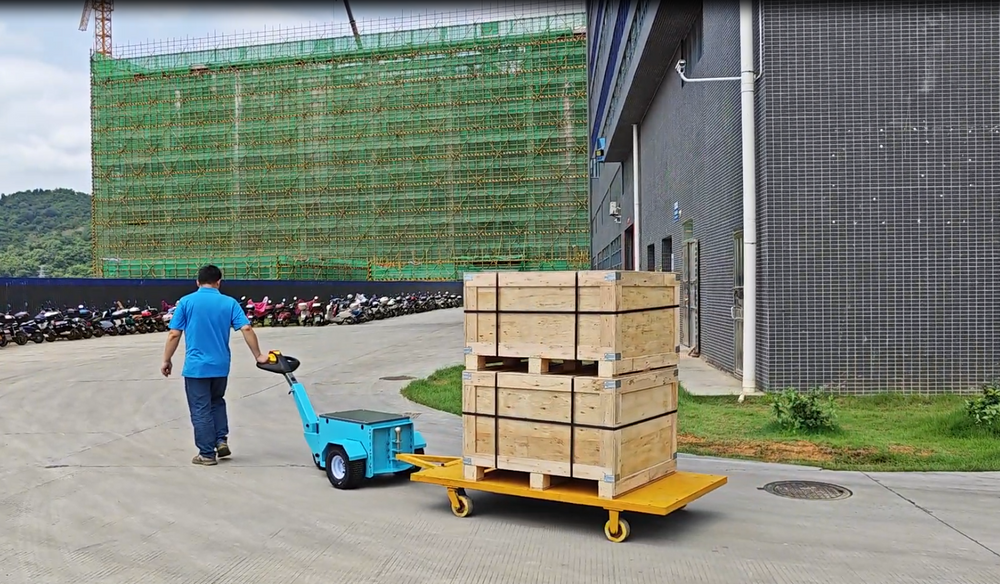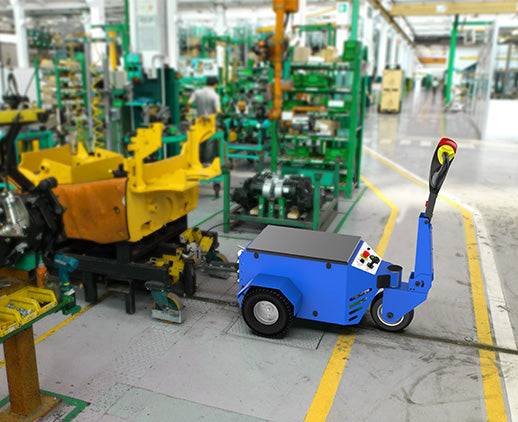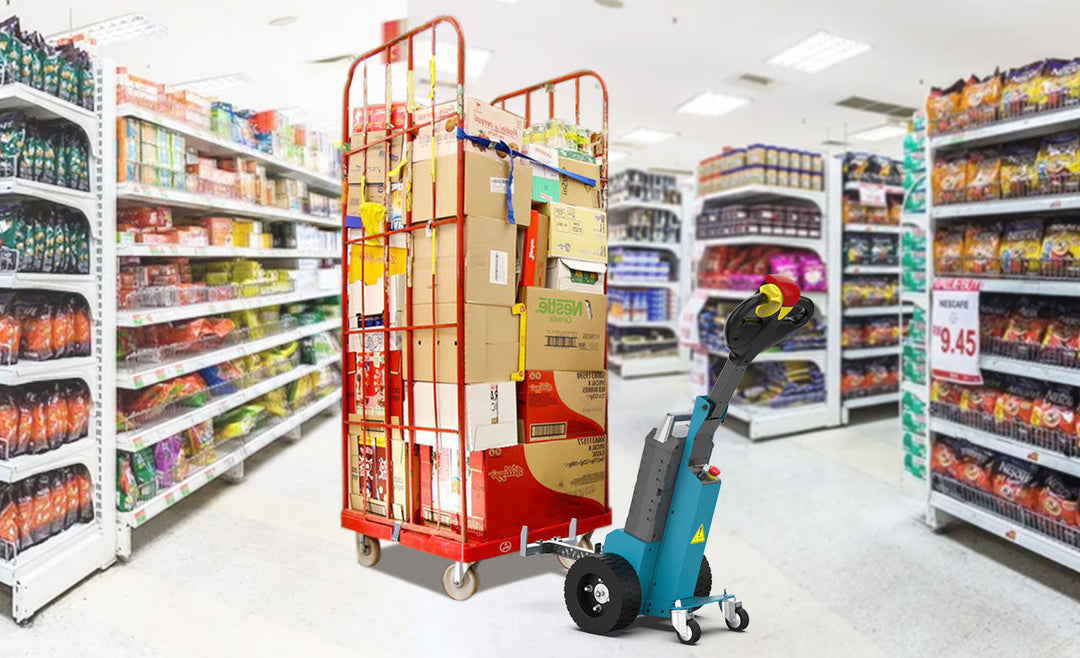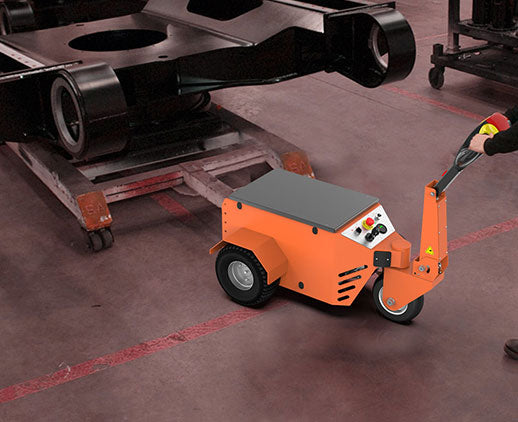What’s the Maintenance for Electric Tuggers

Maintenance for electric tuggers involves annual servicing, checks on batteries every 500 hours, and replacement of the brake pads every 2 years. Regular lubrication reduces energy consumption by 10%, while cleaning cuts failure rates by 25%–30%. Carelessness in that respect can cut the life span by 2–3 years rather than saving on annual maintenance.
Annual Service Booking
For an electric tugger of 2 tons, its power is 3.5 kW, and its normal service life is about 8-10 years. If its maintenance is done on schedule once every year, the average failure rate of the equipment can be reduced from 15% to 5%. Poor maintenance may reduce the equipment lifespan by 2-3 years. A new electric tugger costs $8,400, and it's easy to find out that the cost for early replacement is far more than the annual maintenance expenses.
The electrolyte concentration for the lead-acid battery is generally required every 500 hours, and connectors are to be replaced every 1,000 hours. If these are neglected, not only will a decline of above 10% in battery capacity occur annually, whereas a well-managed battery reduces this to 5% to 7%. In a case where lack of maintenance led to insufficient charge, which caused the downtime of a logistic company and lost $280 per hour, at an aggregate amount of $7,000.
The lubrication maintenance, which is conducted once a year, can reduce the friction coefficient greatly and therefore cut the energy consumption by 10%. For example, after 2,000 hours of operation per year, maintenance can save about 500 kWh of electricity. At an average price of $0.11/kWh, this amounts to savings of $56 annually.
For equipment with average annual running of 2,500 kilometers per year, the replacement of brake shoes is normally done once every two years, costing about $210 each time. Delays in changing the brake shoes will lead to a decrease in braking efficiency by 30% and an increase in braking distance by 20%. According to an industry report, 18% of the equipment accidents in 2023 were caused by brake system failures, each with direct economic losses of over $28,000.
According to research by one of the manufacturers, upgrading the control systems improved operational response speed by 15% and reduced operational errors by 25%. The cold-chain logistics company, through periodic upgrade of its system, had a reduction of equipment failure rates from 12% to 4%, with the increment of operational efficiency by 20%.
According to industry standards, the wearing of electric tugger tires should be checked every six months and changed once a year. More than 50% worn tires would raise the possibility of skidding by 25%, especially on wet surfaces. The most recent example is that there was an accident in the food company where a tugger lost control during transportation and had to damage shelving, its loss amount reached as many as $42,000 whereas tire replacement cost is only $280.
Generally speaking, the annual budget for maintenance accounts for 5% to 8% of the total value of equipment. Therefore, an electric tugger that is $8,400 would require $420-$672 in maintenance every year. Generally speaking, losses caused by not maintaining something are at least three times the cost of such maintenance.
Statistics indicate that electric tuggers, if properly maintained, operate at an average of 10% to 15% efficiency. Equipment that has a load capacity of 2 tons per hour will therefore move an extra 300 tons of goods every year. The efficiency improves after maintenance also cuts the noise by around 20 decibels.
Machine Disassembly
For an electric tugger with rated power of 5 kW, the main components include the motor, control system, brake system, and tires. Normally, it will take 2 to 3 days to take it apart for maintenance, with labor costs of around $210. This accounts for 30% of the annual budget for maintenance. Without disassembly maintenance, equipment failure rates may increase by 20%, which could reduce the lifespan by 3-5 years in the long term.
A technical report in 2022 said that after long-term use, the accumulation of dust and impurities inside the motor of an electric tugger can lead to a power decline of 10%–15%. Disassembling the motor for deep cleaning can restore its original performance and improve operational efficiency by about 12%. Once, a logistics company reduced its energy consumption from 4 kWh to 3.5 kWh per hour after cleaning the motor and saved nearly $168 in electrical bills every year. Moreover, failure rates went down by 25%, and average response time was shortened from 2 seconds to 1.5 seconds thanks to optimized control systems.
The thickness of a brake pad is a critical parameter. If the thickness reduces below 5 mm, the pads must be replaced right away. For every 1 mm reduction in thickness, the braking distances can extend by 10%. In one traffic accident, the failure to replace worn brake pads resulted in brake failure, causing direct economic losses amounting to over $70,000. This could have been achieved by merely changing the pads for $280.
Long-term use of lead-acid batteries results in sulfate buildup on internal plates, reducing its capacity by 15%–20%. The battery should be taken apart and the sulfate removed to restore the battery to 90% of its original capacity. A company managed to increase runtime from 8 to 10 hours and increased daily transport efficiency by 25% after maintenance of the battery.
Tires usually have 30% wear after 12 months. Over 50% wear rates increase the risk of skidding by 40%. Long-term use also increases friction coefficients in bearings by 25%, a condition that contributes directly to increased operating noise by 15 decibels. One of the firms reduced noise and vibration amplitude by 20% through disassembly and replacement of bearings.
Changing gear and lubrication oil needs to be conducted for gearboxes six months later; lack of new replacement accelerates gears to wear, costing more 5–8 percent for annual maintenance, so disassembly gearbox lubricating oil has helped the Company to save almost $420 every year.
Statistics by the industry show that comprehensive disassembly maintenance generally constitutes about 20–25% of the yearly equipment budget. As much as the cost seems pretty high, it reduces unforeseen failures by 40%, increases operational efficiency by 15–20%, with up to 300% return on investment in the long term.
Component Inspection
Statistics from the industry show that 60% of the failure rates come from the aging and destruction of the core components. The core components for a 3-kW electric tugger would be the motor, battery, brake system, and the control module. Regular yearly checks can reduce the failure rate of any equipment from 10% down to 5%. With better checks on components, one logistics company was able to save about 2,800 USD a year in terms of repair costs.
According to the technical manuals, motors should be comprehensively inspected every 1,000 hours of running, including bearing wear, coil insulation performance, and the functionality of the cooling system. Regular inspections can extend motor life by 2-3 years and reduce replacement frequency by 15%. In one case, failure to inspect a motor led to its breakdown, forcing a company to replace it at a cost of 2,100 USD, which could have been avoided with a 210 USD inspection.
In the case of lead-acid batteries, the annual capacity decline rates are around 7-10%. Without due inspections, the capacity of the battery will drop to 60% of its initial capacity in three years. Based on the industry data, every inspection of battery capacity costs 70 USD, while a new average battery costs 1,400 USD. A retail company managed to extend the life span of batteries by up to 3-5 years through quarterly inspections, thereby saving indirectly two replacement costs.
The thickness of the brake pad less than 3 mm increases braking distance by 20%, and operation risk in confined space increases by 35%. Once, a freight company, due to failure to update worn-out brake pads, had a collision incident, leading to a loss of 70,000 USD, while the cost for updating the brake pad would have been 280 USD only.
Annual inspections of control modules can drop failure rates from 12% down to 4%. A cold-chain logistics company increased the precision of operations by 20% and reduced cargo loss rates by 8% through periodic upgrade of software controlling modules.
Full-load operations require tire replacement approximately every 2 years. In case of over 50% wear without a new replacement, the risk of skidding increases by 50%. A logistics company, by enforcing quarterly tire inspections, reduced their rate of tire-related accidents from 10 to 2 annually, saving 42,000 USD in accident costs.
Gear transmission oil viscosity should be checked every 500 operating hours. It needs to be replaced if the viscosity is lowered by more than 20%. Poor lubrication can increase gear wear by 30%, reducing transmission efficiency. A manufacturing company improved energy efficiency by 10% and saved 700 USD annually through enhanced lubrication inspections.
Annual circuit inspections would cost about 110 USD, and repairs for a short circuit could reach as high as 1,100 USD. One transport company, through circuit inspections, avoided two short-circuit incidents and thus saved a total of 2,200 USD for repairs.
Component inspections also include fasteners such as bolts and connectors. Loose fasteners increase vibration by 10%–15%, which can lead to structural integrity degradation over time. A company was able to reduce operational failure rates by 8% and save 14,000 USD annually in repair costs by performing monthly inspections of the fasteners.
Identify Potential Issues
Most failures have clear warning signs before their occurrence, and 75% of the problems can be noticed by routine checks. By implementing weekly inspections, this could reduce sudden failures for a logistics company from 15% to 5%, saving the company 7,000 USD annually in downtime losses.
Lead-acid batteries may lose 10%–15% of capacity within one year. Without timely intervention, this decline compounds, leaving only 60% capacity after three years. Voltage and electrolyte density tests can identify early signs of aging; each inspection costs 70 USD. For a transport company, quarterly inspections prolonged battery life from 3 to 5 years and saved over 2,800 USD.
Brake pad thickness below 3 mm reduces braking performance by 20%–30%, increasing braking distances by 15%–20%. A cold-chain logistics company failed to detect worn brake pads, leading to a slide-off accident with losses exceeding 280,000 USD. Brake system inspections, costing only 110 USD each, offer excellent cost-effectiveness.
Before a short circuit happens, 90% of circuits have abnormal overheating or unstable signals; using infrared temperature monitoring and signal testing can reduce the failure rate of a circuit from 12% to 3%. Using smart detection tools, a manufacturing company saved 4,200 USD annually in circuit repairs, with a 10% rise in operational efficiency.
Excessive tire wear increases skidding risks by 50%. Quarterly tire inspections reduce accident rates from 8% to 1%. A retail company optimized tire inspection processes, saving 14,000 USD annually in accident costs.
If equipment vibration increases by 30%, internal component wear can rise by 50%. Vibration sensors allow real-time monitoring to avoid issues before peak vibrations occur. One logistics company reduced maintenance costs by 21,000 USD annually with this approach.
If motor temperature exceeds rated levels by 10%, its lifespan may decrease by 25%. Regular thermal imaging inspections identify overheating components for repair. A food transport company avoided three motor failures, saving 8,400 USD in repair costs.
Lubrication oil viscosity declining by 20% accelerates gearbox wear by 40%. Oil analysis detects lubrication issues early, costing 140 USD per test. A manufacturing company extended gearbox lifespan by 2 years and reduced maintenance costs by 15% annually.
If loads exceed rated values by 10%, failure rates increase by 25%. Installing load sensors prevents overload failures. A logistics company reduced repair costs by over 7,000 USD annually through load monitoring.
Load-Bearing Check
More than 40% of electric tuggers fail due to overload use. A 2-ton tugger carrying 20% more load faces a 35% increase in failure rate and 50% more component wear. Neglecting inspections costs a logistics company $4,200 annually per downtime, avoidable with $700 annual inspections.
Industry standards suggest ultrasonic inspections every six months to detect internal cracks or fatigue. These inspections identify 80% of potential problems. A manufacturing company saved $2,800 annually by adopting this method.
Load sensor calibration errors can reach 15%, increasing overload risk. Quarterly calibrations, costing $140, reduced overload incidents for a cold-chain transport company from 10% to 3%, saving $7,000 annually.
Operating tires with loads 30% over capacity increases blowout risk by 50%. Annual tire load testing saved a logistics company over $21,000 annually through accident reduction and extended tire life.
Motors running at 90%+ power continuously raise temperatures by 10%, cutting motor life by 25%. Regular load testing helped a transport company save $4,200 annually in motor replacements.
Exceeding load limits by 20% lengthens braking distances by 15%, raising safety hazards. Quarterly brake load tests, costing $112, helped a retail company cut brake-related accidents from 5% to 1%, saving $70,000 annually.
When load exceeds 90% capacity, battery discharge efficiency drops by 10%. Semi-annual tests extended a logistics company’s battery lifespan by 20%, saving $14,000 annually.
Excess vibration exceeding 25% of rated amplitude accelerates component fatigue by 30%. Vibration sensors and regular checks saved a manufacturing company $21,000 annually in related failures.
When load offsets exceed 20%, stability decreases by 40%, raising operational risks. Regular load distribution analysis reduced overturning incidents for a warehousing company from 2% to 0.5%, saving $42,000 annually.
Replace Worn Parts
More than 50% of all electric tugger failures involve excessive wear and tear on critical components. On equipment operating an average of 8 hours a day, key items include brake pads, battery connectors, and tires. Failure rates increase by 30% if worn-out parts are left unattended.
When brake pad thickness goes below 3 mm, braking performance drops by 20% to 30%. A logistics company's failure to replace worn-out brake pads led to a $275,000 accident, while replacing the pads costs only $210.
For a 2-ton electric tugger, tires last 12–18 months under normal use but only 9 months with full-load operations. When tire wear exceeds 50%, blowout risk rises by 40%. Annual replacements costing $420 can prevent accidents costing up to $28,000.
More than 60% of battery failures result from aged or poor-quality connectors. Each connector replacement costs $70, but ignoring this may reduce current efficiency by 10%–15%. Quarterly inspections reduced one company's battery failure rate from 12% to 5%, saving $4,200 annually.
Excessive wear increases noise by 20 decibels and vibration by 30%. Motor bearings typically last 2–3 years. Replacing bearings biennially improves efficiency by 15%, saving a manufacturing company $21,000 annually.
If lubrication oil viscosity drops by 20%, gear wear increases by 50%. Replacing oil costs $110, while gearbox replacement costs $1,400. A logistics company saved $28,000 by replacing lubrication oil semiannually, extending equipment life by 2 years.
Long-term use raises circuit board failure rates due to heat, especially after 5 years. Replacing boards every 3–5 years reduces control system failure rates from 8% to 2%, saving a cold-chain company over $7,000 annually.
Hydraulic system seals wear and leak, reducing pressure by 10%–20%. Seal replacement costs $110–$140 every 2–3 years. One logistics company saved $70,000 annually by reducing hydraulic downtime through regular seal replacements.
Full System Cleaning
Without regular cleaning, equipment failure rates increase by 25%–30% compared to regularly cleaned equipment. Cleaning a standard electric tugger costs about $290 annually, while repairs due to dirt accumulation can exceed $1,400 per incident.
Dust and debris inside motors reduce heat dissipation efficiency, shortening motor lifespan by 15%–20% when temperatures rise by 5°C. A manufacturing company reduced maintenance costs by 15%, saving over $4,300 annually, by cleaning motors quarterly.
Corrosion on the battery terminal will result in a drop of 10%–15% in current transmission efficiency, which increases energy consumption and reduces battery range. This measure saved over $2,800 for a logistics company in battery-related repair every year and prolonged battery life by 2 years.
Uncleaned tires accumulate dirt and gravel, increasing friction coefficients by 20% and accelerating tire wear. By cleaning the chassis and tires once a month, the lifespan of tires has been extended from 18 months to 24 months, saving the transport company $7,200 annually in replacing tires.
Impurities in hydraulic systems increase concentrations, lower the pressure by 10% to 5% to 10%. Annual cleaning of hydraulic systems and replacement filters reduce failure rates by 30%. For hydraulic repair costs, a cold-chain transportation company saved more than $8,600 annually through this measure.
Dust on the control modules increases signal error rates by 5%–8%. Cleaning with compressed air quarterly and isopropyl alcohol reduces the error rates to 1%. One logistics company managed to increase its operation efficiency by 10% and save $11,500 annually in operational costs by doing so.
Dust and debris on brake pads reduce braking efficiency by 15%–20%. A retail company reduced brake-related accident rates by 50% through regular cleaning, saving over $140,000 annually in compensation expenses.
Uncleaned gearboxes build up sludge and metal particles, which increase friction coefficients by 10%–15%. Annual deep cleaning and lubrication reduced energy consumption by 10%. A manufacturing company saved $7,200 annually in energy costs and extended gearbox lifespan.
Accumulation of dust and moisture increases the risk of circuit board short circuits by 30%. Semi-annual professional cleaning reduced circuit failures by 80%, saving a logistics company $5,600 annually in repair costs.












